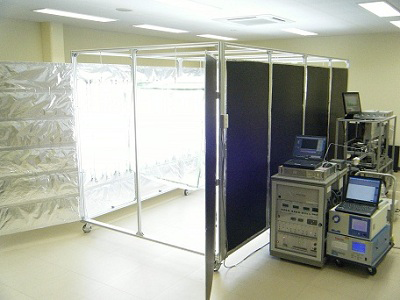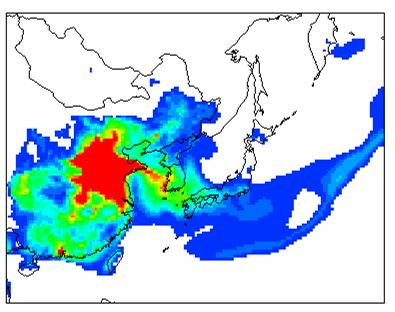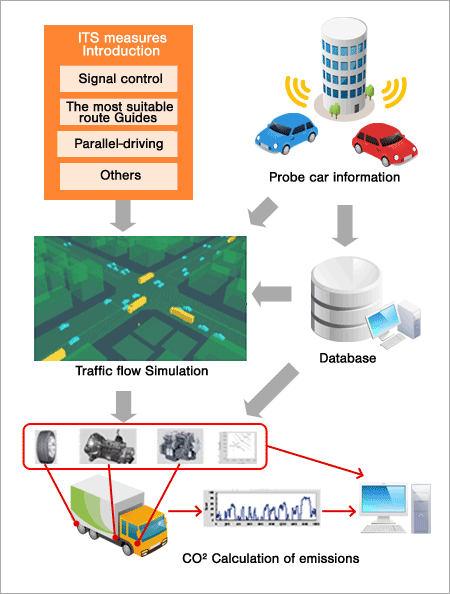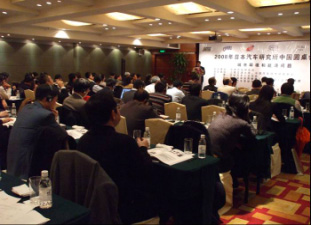Air quality improvement
1) High-sensitivity emissions measurement
With the successful reduction of exhaust emissions, growing attention is directed to other types of emissions such as the dust from the brakes and tires at a time when advanced chemical analysis technology enables the measurement of trace substances. JARI is developing a continuous particle analysis method employing aerosol mass analyzers and continuous ICP-MS (inductively coupled plasma mass spectrometry) analyzers and also a non-volatile substance analysis method applying LC-MS-MS (liquid chromatography-tandem mass spectrometry) analyzers. We are hoping that these analysis methods will be applied to the measurement of automotive emissions and atmospheric conditions in order to give greater accuracy to the assessment of automotive impacts on air quality.
2) PM2.5
Fine particulate matter PM 2.5 existing in the environment are known to contain a large portion of secondary particles generated through chemical reactions in the atmosphere. JARI investigates the secondary particle generation mechanism in the laboratory, examines realworld PM 2.5 situations on the basis of roadside air quality measurement data and air quality simulation techniques, creates a detailed emissions amount inventory, strives to determine the contribution of automobiles to the total amount of existing PM 2.5, and prepares effective PM 2.5 reduction measures targeting automobiles and other fixed or non-fixed emission sources.

Photochemical smog chamber
(Investigating the generation mechanism of PM 2.5 secondary particles)

3) CO2 emissions amount estimation
Because automobiles account for a large majority of CO2 emissions by the transport sector, the auto industry is asked to curb CO2 emissions from motor vehicles. The two major approaches to automotive CO2 emissions reduction are to improve the vehicle's fuel economy performance and to smooth the road traffic flow. JARI estimates future CO2 emissions amounts and traffic flow improvements on the basis of long-term energy and ITS projections, and formulates a world standard technique of assessing the effects of CO2 reductions, and evaluates the CO2 emissions of electric and other next-generation vehicles throughout their total life cycle covering not only the in-use phase but also the phases of resource mining, vehicle scrapping and recycling.

Estimation of ITS effects on CO2 reductions
4) Asian study and international contribution
(1) Promoting emissions reduction in Asia
Asian countries - China, Southeast Asian nations and India in particular - are confronting serious air pollution problems due to rapid motorization and the convergence of population on the big cities. JARI has conducted investigations into local fuel properties, driving and exhaust emission conditions in Southeast Asia in order to assist in its fight against air pollution. We intend to accelerate our cooperation in the improvement of air quality in Asia.
(2) Energy conservation by Chinese part suppliers
As numerous Chinese part suppliers are using equipment with low energy efficiency, it has been an important task to help these firms reduce their energy consumption and their emission of environmental impact substances. In collaboration with CATARC (China Automotive Technology and Research Center), JARI determines and analyzes the amounts of energy consumption in the casting, forging, heat treatment, painting and other processes at the Chinese suppliers to advise them various ways of energy conservation. This joint endeavor of JARI and CATARC has been designated an environmental business promotion model project and is attracting a great deal of attention from Japan, China and elsewhere.
(3) JICA-commissioned training
Commissioned by the Japan International Cooperation Agency, JARI has implemented training of auto-related administrators, engineers and technicians from developing countries since 1990. In recent years we added training courses aimed to foster talents capable of formulating plans for resolving auto-related environmental problems. The JARI training includes classroom lectures, skill training using our equipment, technical tours and discussions at the assembly plants and similar facilities of automakers and other members of the auto industry. A total of 216 people from 44 countries took part in the JARI training and are playing a leading role in their home countries.
(4) JARI Roundtable
Over the recent years the countries in East Asia confronted serious environmental and energy problems due to a dizzy pace of motorization. In response JARI organized its Roundtable event 13 times between 2003 and 2010, hosting a total of 1,300 participants. As a result of the Roundtable, the network of Asian experts expanded and JARI received an increasing number of requests for technical cooperation from East Asia. JARI intends to share its Asian achievements and knowledge with the people worldwide for the resolution of environmental and energy problems.

Scene of a JARI Roundtable conference
